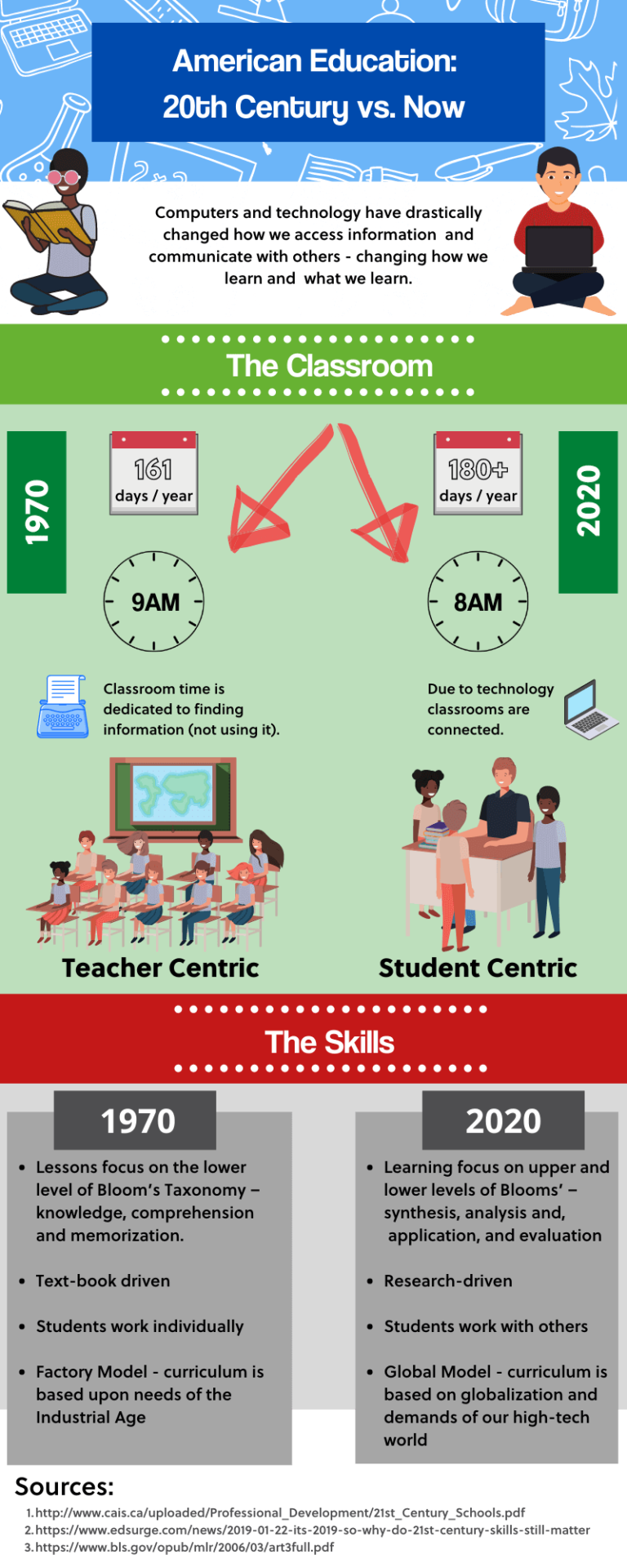
Teachers will need a strong support system as they begin to adapt, make curriculum changes, and overcome obstacles. To meet this, schools may need to cut funding in specific areas, hold fundraisers, or ask parents to pay a fixed annual fee for their students’ access to technology.įinally, once the tools of tech are in place and teachers are on board, it’s time to put the theory into action.
#Evolution of education infographic software#
Purchasing tech devices and software will require a financial commitment. Schools must also strive to secure funding and support to bring tech to the classroom. They must also set goals and expectations on how tech can assist struggling students. Because of this, it’s important that teachers and school administrators set goals and expectations for how tech will help the ways curriculum is taught across every subject area. It’s important to understand where and how the changes will be made. It’s also vital to pinpoint opportunities where tech can be useful. Teachers and school administrators need to identify the causes of hesitation and understand the potential benefits of using tech to teach. Naturally, technology disrupts because it requires changing habits and routines. It’s important to recognize a hesitation to change as technology begins to penetrate education. Furthermore, 88% of students across grades and subjects met proficiency standards, which was an increase from 73%. News & World Report, teachers were able to “tailor instruction to specific groups of students, providing more challenging problem sets to accelerated learners, while simultaneously reviewing concepts with those who require reinforcement.” Three years after the project’s initiation, the district’s graduation increased from 80% to 91%.

A Pioneer to AdmireĪt Mooresville Graded School District, students in 3rd through 12th grade were issued a laptop. Mooresville Graded School District is just one example of this. Many schools and districts across the country have seen positive results from embracing technology in the classroom. From smart tables and voice recognition technology to biometric devices and sensor- and artificial intelligence (AI)- driven natural language processing, these classrooms will create personalized and individualized learning experiences for students. They’re also providing aid to teachers in adapting curriculum to teach students about these tech skills.įinally, the development of the smart classroom is a tech trend poised to create and improve educational experiences. School media centers are introducing various robotics programs and coding initiatives into their repertoire. In VR, an entirely new environment is simulated.Ĭoding and robotics drive another important tech trend. In AR, tech-driven information is overlaid onto an existing environment. This results in the creation of personalized, engaging learning experience for the end user.Ī third trend is an environmental-based tech concept that’s split into two parts: Augmented reality (AR) and virtual reality (VR). This trend deploys algorithms to build educational games. Teachers use the system by uploading material that can then be accessed by students remotely.Īnother key tech trend is a process known as gamification. LMS is a platform designed to create and track various online training initiatives. The first tech trend is known as LMS, short for Learning Management System. Today, five tech trends are credited with creating and improving education. 75% of teachers believe digital learning content will complete phase out printed textbooks by 2026. This device use has lead to fundamental projected shifts in content delivery.

22% of the devices used come from Microsoft Windows, and 19% of the devices used are MacOS and IOS tools. This data leaves little doubt as to why global ed-tech is projected to grow to a $93.76 billion industry by 2020ĥ8% of the devices used by American K – 12 schools are Google products. Of those, more than 30 million primary and secondary school students use Google education apps like Gmail and Google Docs. 35.6 million of those enrolled in pre-K through 8th grade, and 15.1 million of those enrolled in 9th through 12th grade. When Technology Meets Educationĥ0.7 million students enrolled in public elementary and secondary schools in Fall 2017.

To learn more, check out the infographic below created by American University’s School of Education program. From Apple computers to smartphones, iPads, and virtual reality, students and teachers are embracing the exciting educational opportunities offered by technology. It’s virtually impossible to name an industry that hasn’t been transformed by technology.


 0 kommentar(er)
0 kommentar(er)
